Abstract
1 The reduction in the sympathetic efferent discharge observed after propranolol may be due to either a central or a peripheral effect. The beta-adrenoceptor blocking drug, atenolol, is not thought to enter the brain and therefore any reduction in the level of sympathetic efferent discharge observed after atenolol is likely to be mediated peripherally rather than centrally. 2 Cats were anaesthetized with alpha-chloralose and artificially ventilated and a number of variables known to affect the sympathetic nerves were monitored throughout the experiment and maintained within normal limits. Recordings were made from few fibre preparations from the lumber trunk and the renal nerves. Blood pressure was either raised or lowered by the injection of phenylephrine (1-4 microgram/kg) or glyceryl trinitrate (2-20 microgram/kg) and the sympathetic efferent discharge was recorded over a range of blood pressures when the blood pressure was steady. 3 Thirty min after giving atenolol (3 mg/kg) the blood pressure, heart rate and sympathetic efferent discharge were significantly reduced. Atenolol also attenuated the reflex responses of the sympathetic nerves to changes in the blood pressure. 4 It is suggested tht atenolol has its actions on sympathetic nerves at a site outside the CNS and some possible mechanisms are discussed.
Full text
PDF
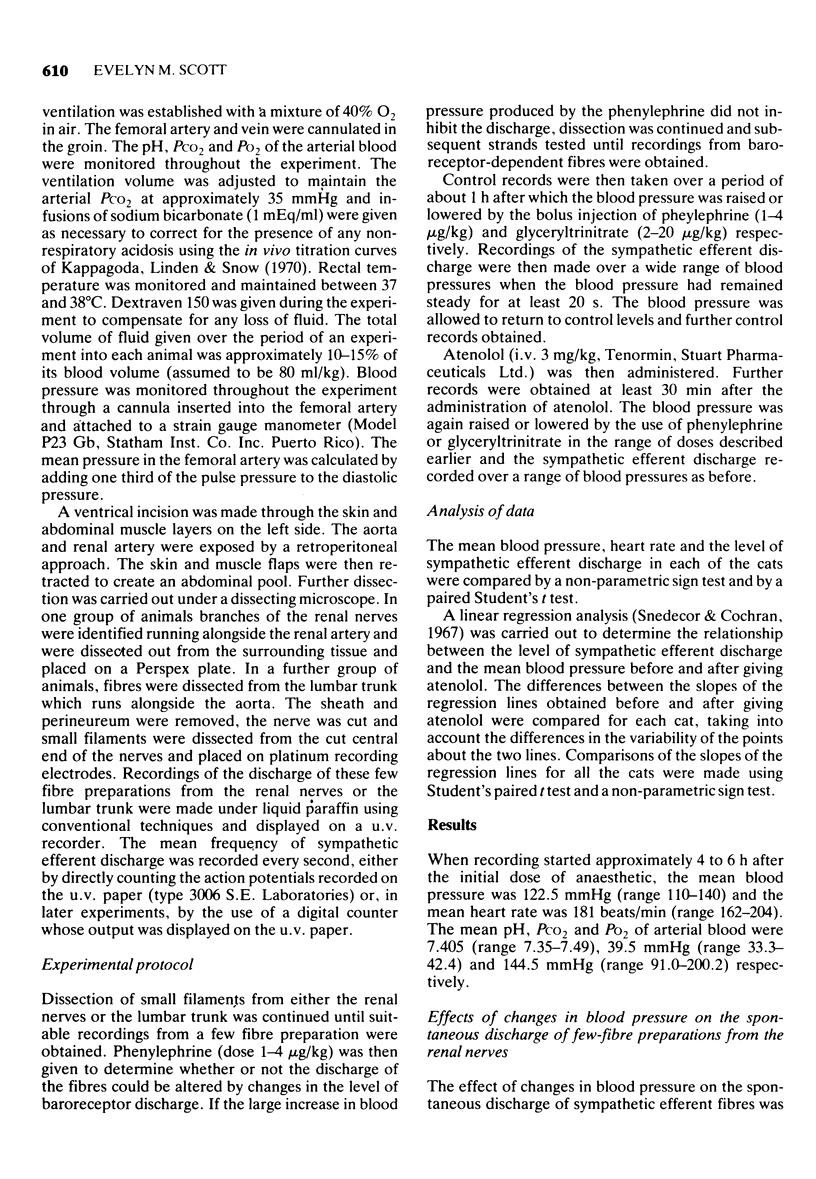
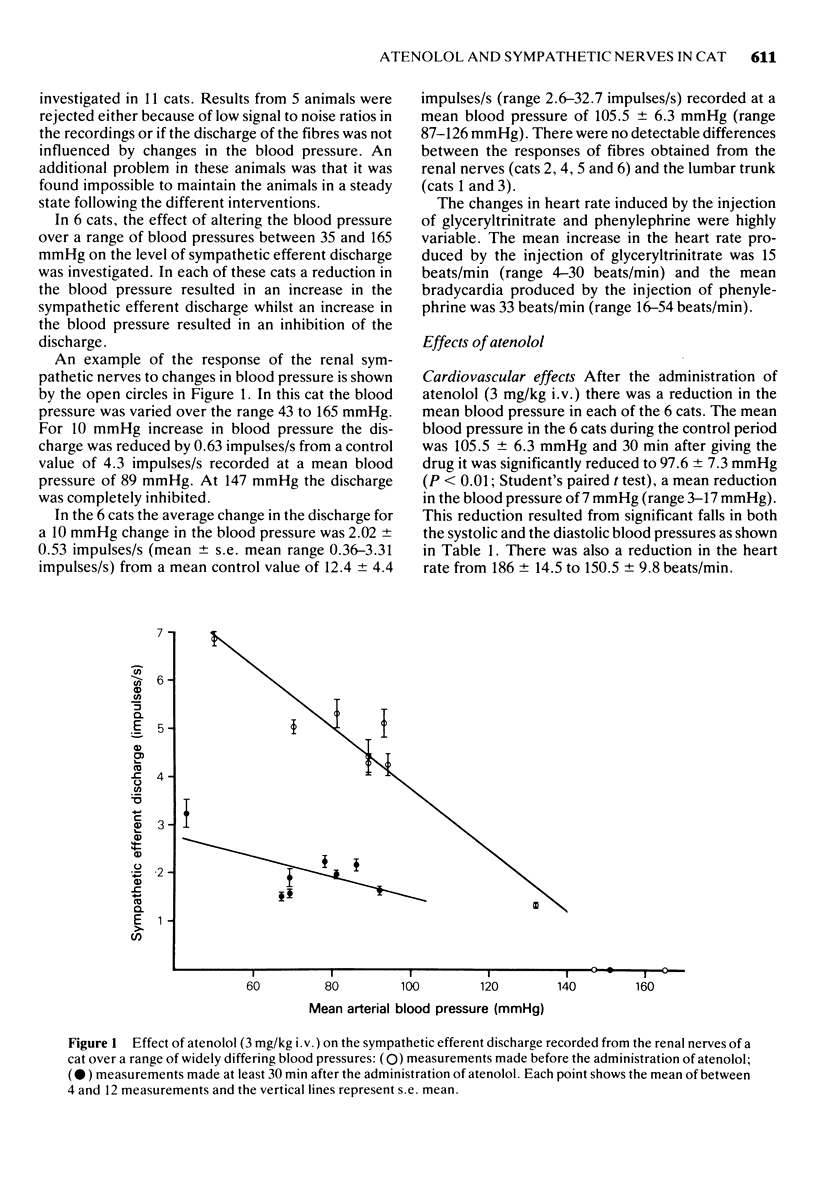

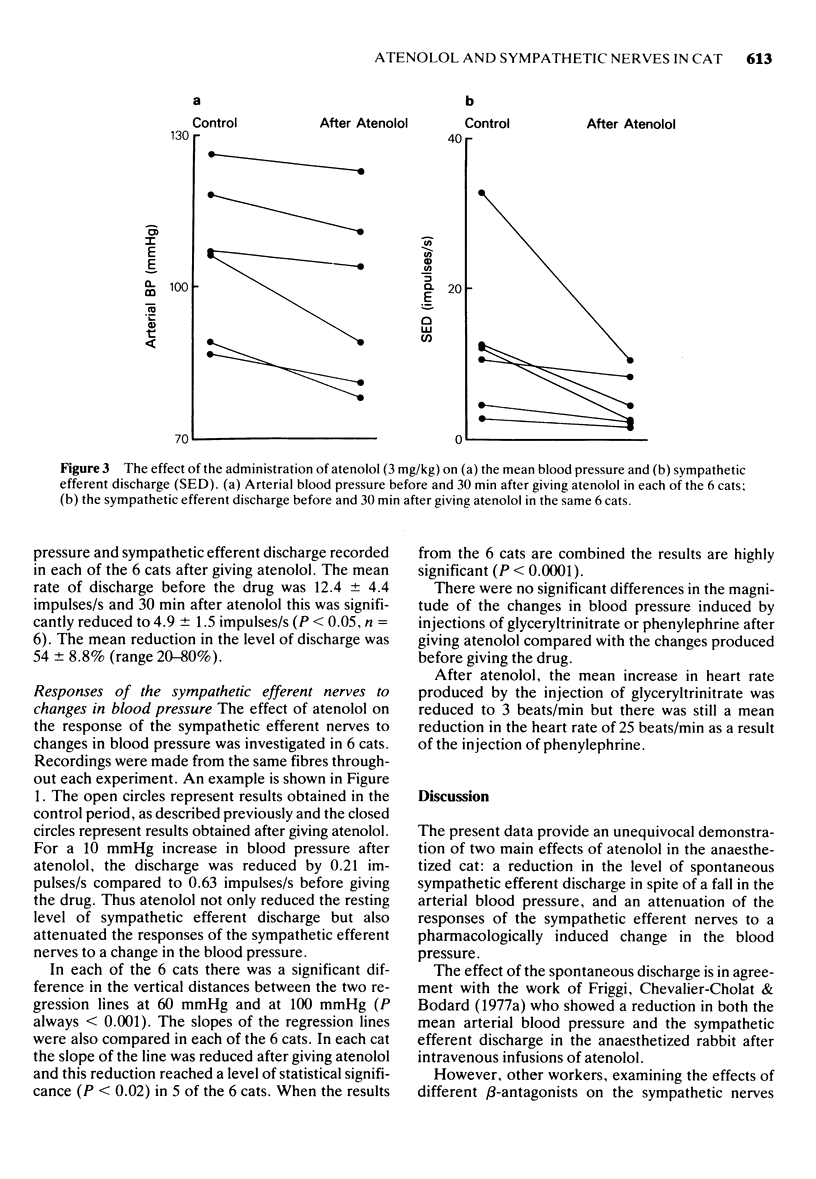
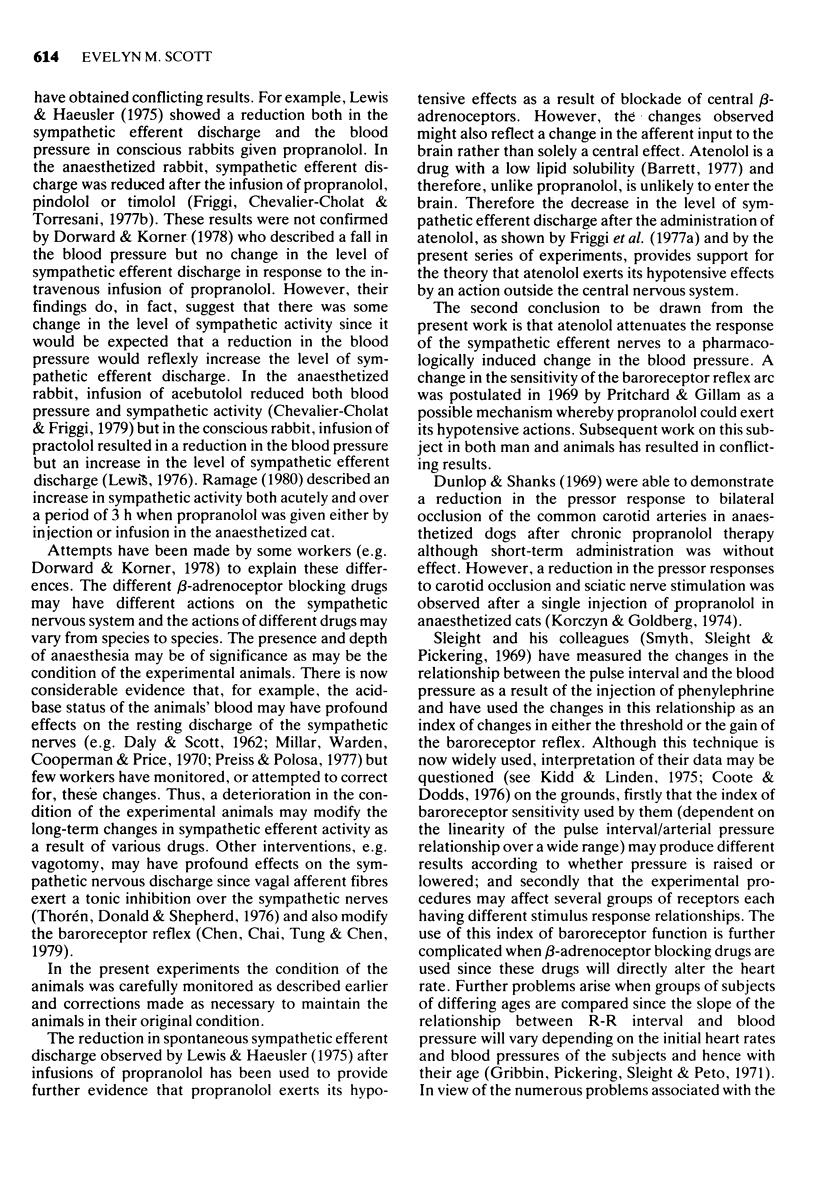
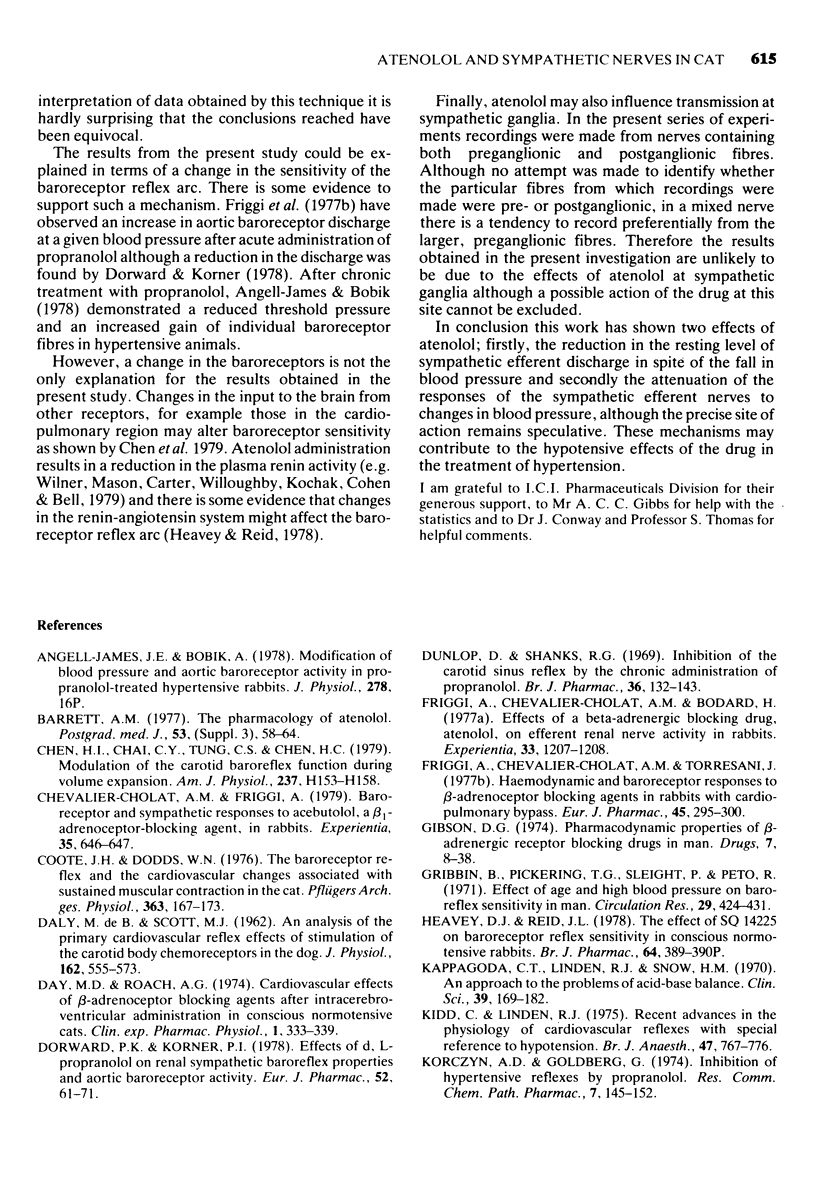

Selected References
These references are in PubMed. This may not be the complete list of references from this article.
- Angell-James J. E., Bobik A. Modification of blood pressure and aortic baroreceptor activity in propranolol-treated hypertensive rabbits [proceedings]. J Physiol. 1978 May;278:16P–16P. [PubMed] [Google Scholar]
- Barrett A. M. The pharmacology of atenolol. Postgrad Med J. 1977;53 (Suppl 3):58–64. [PubMed] [Google Scholar]
- Chen H. I., Chai C. Y., Tung C. S., Chen H. C. Modulation of the carotid baroreflex function during volume expansion. Am J Physiol. 1979 Aug;237(2):H153–H158. doi: 10.1152/ajpheart.1979.237.2.H153. [DOI] [PubMed] [Google Scholar]
- Chevalier-Cholat A. M., Friggi A. Baroreceptor and sympathetic responses to acebutolol, a beta 1-adrenoceptor-blocking agent, in rabbits. Experientia. 1979 May 15;35(5):646–647. doi: 10.1007/BF01960375. [DOI] [PubMed] [Google Scholar]
- Coote J. H., Dodds W. N. The baroreceptor reflex and the cardiovascular changes associated with sustained muscular contraction in the cat. Pflugers Arch. 1976 May 12;363(2):167–173. doi: 10.1007/BF01062286. [DOI] [PubMed] [Google Scholar]
- DE BURGH DALY M., SCOTT M. J. An analysis of the primary cardiovascular reflex effects of stimulation of the carotid body chemoreceptors in the dog. J Physiol. 1962 Aug;162:555–573. doi: 10.1113/jphysiol.1962.sp006950. [DOI] [PMC free article] [PubMed] [Google Scholar]
- Day M. D., Roach A. G. Cardiovascular effects of beta-adrenoreceptor blocking agents after intracerebroventricular administration in conscious normotensive cats. Clin Exp Pharmacol Physiol. 1974 Jul-Aug;1(4):333–339. doi: 10.1111/j.1440-1681.1974.tb00555.x. [DOI] [PubMed] [Google Scholar]
- Dorward P. K., Korner P. I. Effect of d,l-propranolol on renal sympathetic baroreflex properties and aortic baroreceptor activity. Eur J Pharmacol. 1978 Nov 1;52(1):61–71. doi: 10.1016/0014-2999(78)90022-5. [DOI] [PubMed] [Google Scholar]
- Dunlop D., Shanks R. G. Inhibition of the carotid sinus reflex by the chronic administration of propranolol. Br J Pharmacol. 1969 May;36(1):132–143. doi: 10.1111/j.1476-5381.1969.tb08310.x. [DOI] [PMC free article] [PubMed] [Google Scholar]
- Friggi A., Chevalier-Cholat A. M., Bodard H. Effets d'un inhibiteur béta-adrénergique, l'aténolol, sur l'activité efférente du nerf rénal chez le lapin. Experientia. 1977 Sep 15;33(9):1207–1208. doi: 10.1007/BF01922332. [DOI] [PubMed] [Google Scholar]
- Friggi A., Chevalier-Cholat A. M., Torresani J. Haemodynamic and baroreceptor responses to beta-adrenoceptor blocking agents in rabbits with cardiopulmonary bypass. Eur J Pharmacol. 1977 Oct 1;45(3):295–300. doi: 10.1016/0014-2999(77)90013-9. [DOI] [PubMed] [Google Scholar]
- Gibson D. G. Pharmacodynamic properties of beta-adrenergic receptor blocking drugs in man. Drugs. 1974;7(1):8–38. doi: 10.2165/00003495-197407010-00002. [DOI] [PubMed] [Google Scholar]
- Gribbin B., Pickering T. G., Sleight P., Peto R. Effect of age and high blood pressure on baroreflex sensitivity in man. Circ Res. 1971 Oct;29(4):424–431. doi: 10.1161/01.res.29.4.424. [DOI] [PubMed] [Google Scholar]
- Heavey D. J., Reid J. L. The effect of SQ 14225 on baroreceptor reflex sensitivity in conscious normotensive rabbits [proceedings]. Br J Pharmacol. 1978 Nov;64(3):389P–390P. [PMC free article] [PubMed] [Google Scholar]
- Kappagoda C. T., Linden R. J., Snow H. M. An approach to the problems of acid-base balance. Clin Sci. 1970 Aug;39(2):169–182. doi: 10.1042/cs0390169. [DOI] [PubMed] [Google Scholar]
- Kidd C., Linden R. J. Recent advances in the physiology of cardiovascular reflexes, with special reference to hypotension. Br J Anaesth. 1975 Jul;47(7):767–776. doi: 10.1093/bja/47.7.767. [DOI] [PubMed] [Google Scholar]
- Korczyn A. D., Goldberg G. Inhibition of hypertensive reflexes by propranolol. Res Commun Chem Pathol Pharmacol. 1974 Jan;7(1):145–152. [PubMed] [Google Scholar]
- Lewis P. J., Haeusler G. Reduction in sympathetic nervous activity as a mechanism for hypotensive effect of propranolol. Nature. 1975 Jul 31;256(5516):440–440. doi: 10.1038/256440a0. [DOI] [PubMed] [Google Scholar]
- Lewis P. The essential action of propranolol in hypertension. Am J Med. 1976 May 31;60(6):837–852. doi: 10.1016/0002-9343(76)90904-9. [DOI] [PubMed] [Google Scholar]
- Millar R. A., Warden J. C., Cooperman L. H., Price H. L. Further studies of sympathetic actions of anaesthetics in intact and spinal animals. Br J Anaesth. 1970 May;42(5):366–378. doi: 10.1093/bja/42.5.366. [DOI] [PubMed] [Google Scholar]
- Myers M. G., Lewis P. J., Reid J. L., Dollery C. T. Brain concentration of propranolol in relation to hypotensive effect in the rabbit with observations on brain propranolol levels in man. J Pharmacol Exp Ther. 1975 Feb;192(2):327–335. [PubMed] [Google Scholar]
- Preiss G., Polosa C. The relation between end-tidal CO2 and discharge patterns of sympathetic preganglionic neurons. Brain Res. 1977 Feb 18;122(2):255–267. doi: 10.1016/0006-8993(77)90293-1. [DOI] [PubMed] [Google Scholar]
- Prichard B. N., Gillam P. M. Treatment of hypertension with propranolol. Br Med J. 1969 Jan 4;1(5635):7–16. doi: 10.1136/bmj.1.5635.7. [DOI] [PMC free article] [PubMed] [Google Scholar]
- Smyth H. S., Sleight P., Pickering G. W. Reflex regulation of arterial pressure during sleep in man. A quantitative method of assessing baroreflex sensitivity. Circ Res. 1969 Jan;24(1):109–121. doi: 10.1161/01.res.24.1.109. [DOI] [PubMed] [Google Scholar]
- Tarazi R. C., Dustan H. P. Beta adrenergic blockade in hypertension. Practical and theoretical implications of long-term hemodynamic variations. Am J Cardiol. 1972 May;29(5):633–640. doi: 10.1016/0002-9149(72)90164-6. [DOI] [PubMed] [Google Scholar]
- Winer N., Mason W. D., Carter C. H., Willoughby T. L., Kochak G. M., Cohen I., Bell R. M. Effects of atenolol on blood pressure, heart rate, renin, and norepinephrine during exercise. Clin Pharmacol Ther. 1979 Sep;26(3):315–325. doi: 10.1002/cpt1979263315. [DOI] [PubMed] [Google Scholar]


